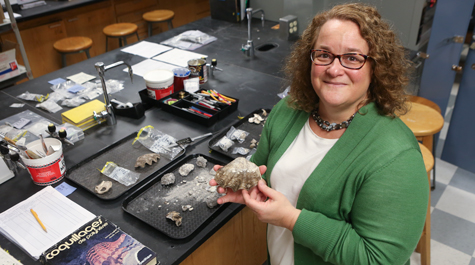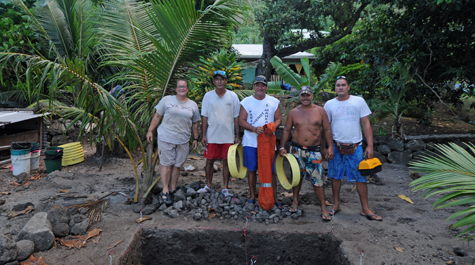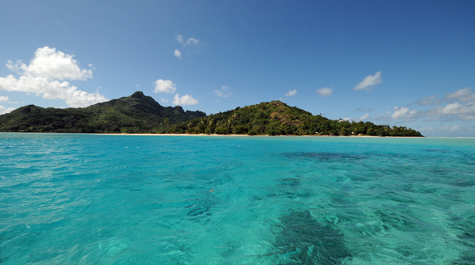At AAAS: Boatloads of pigs and a lesson in cultural ecology
Some 1,000 years ago, a group of settlers loaded into double hulled outrigger canoes and headed east, bound for one of the last remote regions to be colonized by humans. They set off from their native shores with a prized cultural resource: boatloads of pigs.
“When settlers left western Polynesia to colonize the east, they got into canoes and brought with them a whole bunch of animal and plant species,” said Jennifer Kahn. “They knew that the islands weren’t going to have a lot of things that they needed, so they brought with them this Polynesian idea of what they wanted to eat.”
{{youtube:medium:left|CeUu8WlwjC4, Anthropogenic interactions in Polynesia}}
Kahn is an associate professor of anthropology at William & Mary who studies human environmental interaction. She briefed attendees at the annual meeting of the American Association for the Advancement of Science on her research into socio-ecosystem resilience in East Polynesia.
She is part of a worldwide group of scientists who are using archaeological data and ecological modeling to examine how different cultures use animal and plant taxa in diverse ways. She discussed her findings in a session titled Anthropogenic Interactions in Polynesia: Modeling Sustainability with Human Use Webs.
“Our case study is really important because eastern Polynesia was settled from western Polynesia about 1,000 years ago, so we have a very short chronology to look at,” Kahn said. “The settlers knew they needed to bring species with them. They knew from exploration myths and lore that when you got to an island, there weren’t any mammals to eat and you needed to bring agricultural crops to grow.”
The settlers brought with them tropical root crops and tree crops, as well as pigs, dogs, and chickens. While boats were stocked with the same supplies, the colonizers had dramatically different outcomes depending on where they came ashore.
Kahn’s research compares the colonization of two archipelagoes in French Polynesia, the Society Islands and Gambier Islands. The two groups of islands differ in geological age, soil nutrient profiles and terrestrial-to-marine use ratios, Kahn explained, but both regions were colonized using the same set of Polynesian resource strategies – with dramatically different outcomes.
“They brought the same means of survival to two different island systems,” Kahn said. “They are putting the same system into each place, but over time they have to adapt it to local environments. One group of islands, the Gambier Islands, was more isolated than the other. It was old and had less nutrient rich soils, but it had a better marine system. This is an excellent case study for looking at the chicken-and-egg question of whether the ecology shapes culture or culture shapes ecology.”
Utilizing both archaeological and historical datasets, Kahn was able to drill down into how decisions made by Polynesians living in the islands transformed the landscape, which led to changes in their social and political systems.
“Polynesians were taking their one system and mapping it onto different environments,” Kahn said. “It really worked quite well in the resource-rich, productive environments, but when you push to the margins, it becomes much more difficult and the same things don’t always work.”
For example, in both systems vulnerable ground-nesting bird species quickly went extinct, but in Gambier Islands the effects of that loss were felt, Kahn explained. Gambier Islanders not only lost the birds as food stuffs, but lost the nutrients that bird poop recycled back into the system, a decisive loss in a nutrient poor environment.
Communities were forced to change their food-procuring practices, which led to an increase in domesticated plants and animals. This caused dramatic changes to island environments.
“The effects of more limited plant biodiversity and land clearance via slash and burn caused massive slope erosion,” Kahn said.
As the environment changed, island residents shifted to more sustainable and productive farming practices, including terracing hillsides to reduce soil erosion, and multi-cropping in tree gardens. The Society Islands have a larger useable land mass than the Gambiers, Kahn said, so the environment could accommodate more terraced farming and therefore produce more crops.
“The Society Islands really benefit in the long term to making this shift to more conservationalist forms of agriculture,” Kahn said. “It allowed for the population to grow and get more socially complex. There is a big correlation between the amount of stratification or social complexity, resource base and human demography.”
Kahn says the population tipping point is about 3,000. After an island reaches about 3,000 inhabitants, the style of governing changes.
“Once you’re beyond that, leaders can start getting away with things that a leader on a smaller scale can’t get away with,” Kahn said. “It allows for things like tribute and taxation and the development of a chiefly class that lives very differently than everybody else.”
She argues that the higher biodiversity and wider availability of arable land on the Society Islands likely provided a “significant buffer for ancient Polynesians when mitigating resource stresses from overpopulation, significant weather events such as tsunamis and hurricanes, and climatic change.” This created the conditions for a more complex society.
In the Gambiers, on the other hand, the population struggled to grow until residents opted for the deliberate elimination of a prized protein source, pigs. While pigs were the most highly valued mammals, competition with humans for the same foods led Gambier inhabitants to choose to eliminate pigs from their island.
“The Gambiers got rid of pig themselves as a cultural decision,” Kahn said. “In order for the human population to survive, they had to make the decision to get rid of pigs. That’s a hard decision and we find this decision being made in other smaller Polynesian islands with less productive resources, such as Maupiti, the smallest and driest island in the Societies. It shows that human societies are making difficult decisions for their long-term resilience.”
Such a bold choice gives Kahn hope for future societies, island-bound or not. She hopes the history of eastern Polynesia will serve as both inspiration and a warning for other resource-limited cultures.
“If societies make hard decisions, they can be adaptive and resilient in the long term,” Kahn said, “but if you wait too long to make those changes, sometimes you hit a bottleneck effect where you can’t go ever go back.”
In order to look at the history of the two island groups over time, Kahn and her colleague, Dr. Patrick Kirch of the University of California, Berkeley, drew upon experts in numerous disciplines, including geology, soil science, botany, and archaeology.
Kahn worked with researchers who assessed agricultural productivity throughout the islands by using GIS modeling of soil type, nutrients, and slope. Geologists tracked environmental change over time by using pollen cores and charted landscape change through charcoal analysis. Archaeologists analyzed microfossils to examine starch and pollen grains in soil samples to figure out what was being planted.
“It can be really difficult to separate what’s a culturally caused problem and what’s an environmentally caused problem,” Kahn said. “That’s why it’s so important to have interdisciplinary work, because an archaeologist might tend to look at human impact while a biologist or an ecologist might look toward the natural environment, but seeing the interactions between the two is really important.”
For more information about Kahn’s AAAS session, click here.

















